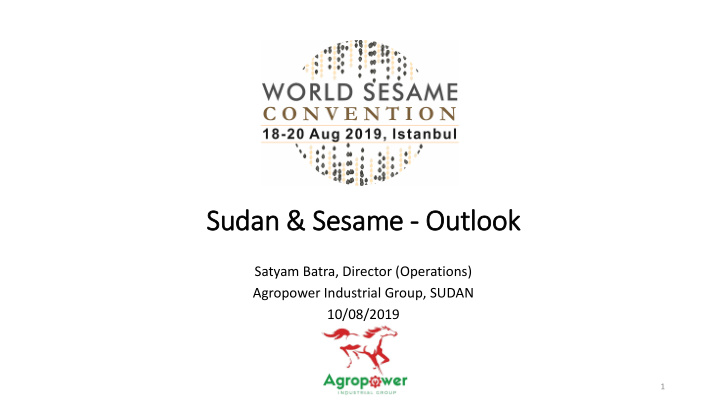



Sudan & & Ses esame - Ou Outlook ook Satyam Batra, Director (Operations) Agropower Industrial Group, SUDAN 10/08/2019 1
Sesame in Sudan • One of the Oldest Oilseed Crops in the Country. Records of Wild Growth and Camel-driven Oil Mills registered in early 1900s. • British Government Introduced Mechanized Agriculture Methods in 1940s. • 88% of Cotton Agriculture has shifted to Sesame, Sorghum, Wheat and other Cash Crops between 1970 to 2014. • Cultivated in South-Eastern Regions of Sudan; Weather and Labour Costs Supportive. • Around 5 million hectares under Sesame Seed Cultivation Currently. 2
Cultivation Coordinates Land Coverage - 2018/19 Crop • Southern Kordofan State – 400,000 hectares • White Nile State – 420,000 hectares • Blue Nile State - 336,000 hectares • Sennar State – 860,000 hectares • El Gedaref State – 500,000 hectares • Kassala State – 147,000 hectares 3
Sesame in Sudan – The Shift • Shorter Crop Cycle • Less Prone to Extreme Weather Conditions • Sesame Farmers enjoy Private Crop Financing Modules • Lesser Water & Fertilizer Requirements 4
Production Trends • From Less Than a Million Hectares Cultivated in 2011, Sesame Agriculture has been growing manifolds to an expected Land Coverage of 4.8 Million Hectares in 2019. • CAGR of 12% in Crop Volume from 2018 crop. (981,000 MT) • Ratio of Mechanized Agriculture in Sesame Plantations Improved from 30% in 2017 to 60% in 2018. • Overall Yield/ha Improved from 0.24 ton/ha to 0.31 ton/ha in Mechanized Agriculture Areas. 5
Production Trends Data Source FAO 6
Production Trends • 2015-2019 shows Continuous Growth Pattern • 2015-2016 witnessed Increased Local Investment of Cleaning Facilities, Thus Creating Additional Crop Demand. • 2019 Projects 1.1 million tons at an Annual Growth Trend of 0.25 tons/ha, With an Increase in Area Cultivated from 4.5 million hectares to 4.8 million hectares. • Private Financing, Devaluated Local Currency, 2018 Erratic Weather Conditions led to Increased Land Coverage. 7
Output and Export – Sesame in Sudan Sesame - Output vs Export 71% 7,04,568 Export 2018 9,81,000 70% 5,50,496 2017 Export 7,81,000 4,67,629 89% 2016 Export 5,25,000 0 2,00,000 4,00,000 6,00,000 8,00,000 10,00,000 12,00,000 EXPORT OUTPUT Data Source 8 Central Bank of Sudan
Output and Local Consumption Sesame in Sudan • 2017 onwards, A continuous 28-29% pattern of Local Consumption is Observed from Total Output of Sesame in Sudan. • Surge Prices of other Edible Oils (Sunflower, Groundnut, Cottonseed) led to a growth in the demand of Sesame for Oil Processing. • Considering an Average 200,000 tons Local Consumption Annually, Sudan Population Growth Rate is 2.4% only, An Assumed 900,000 tons should be available for 2019 Export. (Export 2019 Q1, Q2 – 299,012 tons) 9
Politics & Sesame in Sudan • Sudan – Transitional Civil-Military Coalition Government is Under Progress. • Q4 2018, Q1 & Q2 2019 has witnessed Severe Economical Hits due to Civil Unrest, Port Delays and Cash & Fuel Shortages. • Transitional Coalition – Promises a Bright Future in Trade and Economics of the Country. • Currency Stability – The Prevalent Parallel Market has been stable in the Transition Period. • A Stable Civilian-led Government can support removal of Long-Standing Economic Sanctions. 10
Pricing Prospects • 2019 Q1 Sudan Sesame Traded at an average price of 1650$, Maintaining Similar Price Lines for Q2. • 2019-20 Crop may see an Increase in Price due to a lot of factors; Heavy Rainfall and Water-Logging around Cultivation Regions Labour Wages Increased due to High Inflation Increased Local Demand, Sesame Oil Consumption Increased due to fluctuating Edible Oil Pricing. Chronic Fuel Shortage has delayed Tilling and Ploughing Process. 11
Future of the Golden Seeds • New Sorting, Cleaning and Hulling Facilities in Sudan will help improve the Value-Chain of Sesame from Sudan. • Weather Tolerant Hybrid Seeds Distribution Programme from FAO/Ministry of Agriculture and Forestry, Sudan will be at broader spectrum. • Port Sudan Facilities under development; Faster Cargo Movement and Improved Export Taxation Policies. • International Banking Facilities post Sanction Removal should be supporting Crop-Financing. 12
Recommend
More recommend